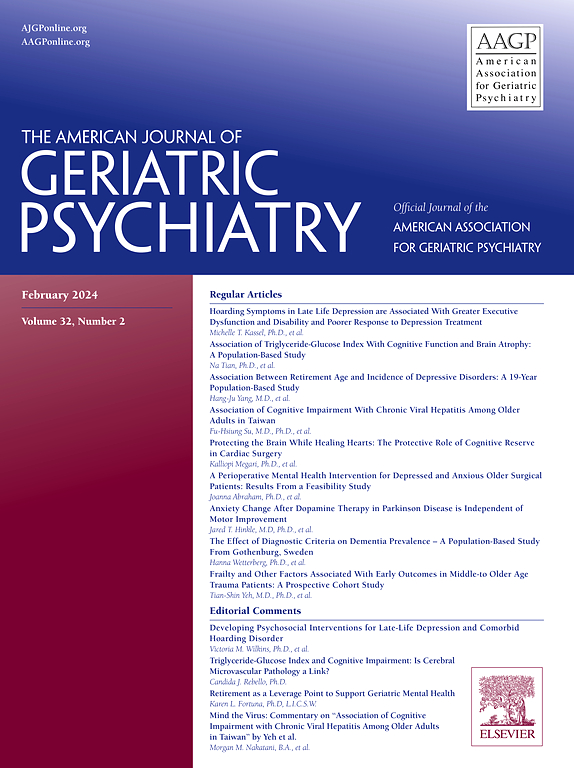28. 布雷哌唑治疗阿尔茨海默病引起的痴呆相关躁动:需要治疗的数量,需要伤害的数量,以及被帮助或伤害的可能性
IF 3.8
2区 医学
Q1 GERIATRICS & GERONTOLOGY
引用次数: 0
摘要
躁动是阿尔茨海默病的一种普遍的、高度痛苦和沉重的神经精神症状。在这一弱势患者群体中,最大化获益、最小化风险和了解预期治疗结果尤为重要。该分析通过治疗所需数量(NNT)、伤害所需数量(NNH)和帮助或伤害的可能性(LHH),描述了brexpiprazole在阿尔茨海默病引起的痴呆相关躁动患者中的临床获益和风险概况。方法汇总来自两项固定剂量的关键性临床试验的数据,brexpiprazole用于治疗阿尔茨海默病引起的痴呆相关躁动患者(NCT01862640 [Trial 283], NCT03548584 [Trial 213]),并分析brexpiprazole 2或3mg /天(fda批准的推荐至最大剂量)与安慰剂的对比。在两项试验中,Cohen-Mansfield躁动量表(CMAI)是主要的疗效测量。在这项事后分析中,主要疗效指标是躁动反应率,定义为从基线到第12周CMAI总分降低≥20分。先前的分析表明,人体内CMAI降低20点反映了该人群有临床意义的获益。主要的安全性指标是由于治疗中出现的不良事件(teae)而停药的发生率。其他疗效和安全性结果也进行了分析。对于确定的结果,计算NNT、NNH和LHH。NNT和NNH表明,为了使一个额外的患者体验到益处(NNT)或伤害(NNH),需要多少患者接受布雷吡拉唑和安慰剂的治疗。LHH是NNH与NNT的比值。较低的NNT值和较高的NNH和LHH值比安慰剂更支持brexpiprazole。结果brexpiprazole的有效率(≥20点CMAI Total reduction)为50.1% (182/363),placebo为37.7% (93/247),NNT为9(95%置信区间[CI]: 5,22)。brexpiprazole因teae而停药的发生率为4.9% (18/366),placebo为4.8% (12/251),NNH为730 (95% CI:无统计学意义)。综上所述,这些具体结果导致LHH为81。结论brexpiprazole获得治疗缓解(CMAI总分降低≥20分)的可能性是因TEAE而停药的81倍。该分析为brexpiprazole治疗阿尔茨海默病痴呆相关躁动患者的获益和风险提供了有意义的临床解释。这些数据扩大了brexpiprazole的证据基础,并强调了brexpiprazole在该患者群体中使用的良好疗效和安全性。为了有足够的时间讨论方法,并最终确保选择临床相关的结果,本摘要在截止日期前提交。本文章由计算机程序翻译,如有差异,请以英文原文为准。
28. BREXPIPRAZOLE FOR AGITATION ASSOCIATED WITH DEMENTIA DUE TO ALZHEIMER’S DISEASE: NUMBER NEEDED TO TREAT, NUMBER NEEDED TO HARM, AND LIKELIHOOD TO BE HELPED OR HARMED
Introduction
Agitation is a prevalent, highly distressing and burdensome neuropsychiatric symptom of Alzheimer’s disease. In this vulnerable patient population, it is especially critical to maximize benefits, minimize risks, and understand expected treatment outcomes. This analysis delineates the clinical benefit and risk profile of brexpiprazole in patients with agitation associated with dementia due to Alzheimer’s disease, using number needed to treat (NNT), number needed to harm (NNH), and likelihood to be helped or harmed (LHH).
Methods
Data are pooled from two fixed-dose pivotal clinical trials of brexpiprazole in patients with agitation associated with dementia due to Alzheimer’s disease (NCT01862640 [Trial 283], NCT03548584 [Trial 213]), and analyzed for brexpiprazole 2 or 3 mg/day (FDA-approved recommended-to-maximum dose) versus placebo. In both trials, the Cohen-Mansfield Agitation Inventory (CMAI) was the primary efficacy measure. For this post hoc analysis, the main efficacy outcome was agitation response rate, defined as ≥20-point reduction in CMAI Total score from baseline to Week 12. Previous analyses indicate that a 20-point within-person CMAI reduction reflects a clinically meaningful benefit in this population. The main safety outcome was incidence of discontinuation due to treatment-emergent adverse events (TEAEs). Other efficacy and safety outcomes were also analyzed. For the identified outcomes, NNT, NNH and LHH were calculated. NNT and NNH indicate how many patients would need to be treated with brexpiprazole versus placebo in order for one additional patient to experience a benefit (NNT) or a harm (NNH). LHH is the ratio of NNH to NNT. Lower NNT values, and higher NNH and LHH values, are more supportive of brexpiprazole versus placebo.
Results
Response rates (≥20-point CMAI Total reduction) were 50.1% (182/363) for brexpiprazole, and 37.7% (93/247) for placebo, yielding a NNT of 9 (95% confidence internal [CI]: 5, 22). The incidence of discontinuation due to TEAEs was 4.9% (18/366) for brexpiprazole, and 4.8% (12/251) for placebo, yielding a NNH of 730 (95% CI: not significant). Together, these specific outcomes result in a LHH of 81.
Conclusions
Brexpiprazole is 81 times more likely to result in treatment response (as defined by a ≥20-point reduction in CMAI Total score) than discontinuation because of a TEAE. This analysis provides meaningful clinical interpretation of benefits and risks of brexpiprazole in patients with agitation associated with dementia due to Alzheimer’s disease. These data expand the evidence-base for brexpiprazole, and underscore the favorable efficacy and safety profile that supports the use of brexpiprazole in this patient population.
This abstract was submitted at the late-breaker deadline to allow sufficient time to discuss the methodology, and ultimately ensure that clinically relevant outcomes were selected.
求助全文
通过发布文献求助,成功后即可免费获取论文全文。
去求助
来源期刊
CiteScore
13.00
自引率
4.20%
发文量
381
审稿时长
26 days
期刊介绍:
The American Journal of Geriatric Psychiatry is the leading source of information in the rapidly evolving field of geriatric psychiatry. This esteemed journal features peer-reviewed articles covering topics such as the diagnosis and classification of psychiatric disorders in older adults, epidemiological and biological correlates of mental health in the elderly, and psychopharmacology and other somatic treatments. Published twelve times a year, the journal serves as an authoritative resource for professionals in the field.

 求助内容:
求助内容: 应助结果提醒方式:
应助结果提醒方式:


